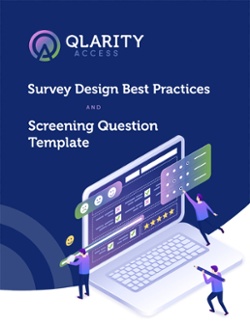
A Research Project is a Journey: Scope the Project Right the First Time
Setting up a market research project for success requires scoping the project correctly from the get-go, to provide clarity and direction to decision makers. Consultants are the guides that carry clients through the journey from ideas to actionable outcomes. Without a plan and clear guidelines, though, projects can deviate and become cumbersome, oftentimes falling short of providing any clear direction. This blog post seeks to help projects stick to the path, empowering consultants to articulate their needs and partake in transparent discussions by focusing on what really matters. The ultimate goal? To consolidate scoping upfront with clients, and ensure clarity and accuracy from the outset for truly actionable results.
PROJECT ROADMAP ESSENTIALS:
Consultants must navigate the journey of each project with precision. Research design begins with asking the right questions and ends with proper communication and reporting. Arm yourself with these steps to chart a successful path forward.
Setting the Project's Compass: The Fundamental Questions
Every successful project begins with a clear roadmap, and at its heart lie the fundamental questions. These questions are not mere starting points; they serve as the project's compass, ensuring that every step taken aligns with the intended direction and end goal. By addressing these questions with stakeholders upfront, consultants can crystallize their vision, define tangible goals, kick off the project on the right foot, and bring everyone back into alignment as needed. In the whirlwind of project complexities, these questions remain the steadfast true north, bringing clarity to the purpose and making sure that every decision resonates with the project's core objectives.
What do you aim to achieve?This query isn't just procedural; it shapes the project's trajectory. By setting clear objectives from the start, we align every action with our desired results, steering clear of potential missteps and moving purposefully towards success. |
|
What impact will the project have?Outside of just immediate deliverables, this question delves into the broader implications of our efforts. It prompts us to consider the long-term value and potential ripple effects, ensuring that our actions serve a larger, impactful purpose. |
|
What does this project look like upon completion?Having decision makers discuss what completion of the project looks like ensures that everyone has the same endpoint in mind. By having an endpoint, all can agree when work is done. |
|
How do you determine a successful outcome?Beyond merely reaching an endpoint, it's about envisioning the project's full impact. This question helps define tangible results and intangible shifts, guiding the journey and ensuring that final results echo the initial vision. |
While these questions may seem similar to each other, the answers given usually vary at least a bit. By utilizing the similarities in the answers, it is possible to flush out and triangulate the root objectives and needs of the research. The places where the answers differ bring color to additional goals or motivations.
Charting a Clear Course: Laying the Groundwork for Research
Having set the project's compass, it's crucial to lay down specifics that guide its course. Think of this as charting the detailed path after determining your direction. Here's how to ensure your research follows the path set by the compass:
Methodology - Drawing the Map:
Once the destination is clear from setting your project's compass to true north, the journey's route needs defining. The methodology does precisely this by drawing a map. By selecting the right tools and techniques, we're deciding on the best paths to take. This encompasses determining the number of participants, the duration of interviews, and the specific research methods that best fit our objectives.
Target Audience - Identifying Fellow Travelers:
No journey is undertaken alone, and recognizing your companions is vital. In the world of marketing research, your companions are the members of the target market that you're looking to understand. It's more than just gathering market research participants; it's about diving deep to make certain a wide spectrum of voices are heard, capturing a holistic, comprehensive picture of the landscape. Avoid overlooking any essential voices, and prioritize tapping into primary sources like the sales teams for the most accurate data.
Data Sources - Collecting Tools:
Before setting out on any journey, a good traveler needs tools. The data source that a company uses is one such tool. Identifying a target market is just the first step; sourcing those people is the next level. The origin of data greatly influences the quality and reliability of research outcomes. Whether it's client lists provided directly by clients or participants gathered from external sources, it's essential that every piece of data stands up to scrutiny and is both pertinent and trustworthy.
Navigating the Journey: Conducting Research Through Changes and Unexpected Hurdles
Once the project's compass is set, it's imperative to anticipate and circumvent common obstacles. Here's how to keep your project on its charted course:
Scope Creep - Sticking to the Map:
Sometimes, projects tend to expand beyond their original objectives, leading to scope creep, which can hinder progress.
-
Distinguish between "need-to-have" and "nice-to-have." This is essential for streamlined processes and focused outcomes.
-
Stay aligned with the foundational research questions. They serve as your north star, ensuring you remain on the predetermined path.
-
Handle internal stakeholder meetings and expectations. Avoid detours by setting clear agendas and staying aligned with the project's agreed upon goals.
Client Lists - Quality Over Quantity in Companions:
An extensive client list can be good, but its true value lies in the quality and relevance of the contacts.
-
Verify the accuracy and quality of client lists. A comprehensive list isn't necessarily a treasure trove; it's the quality of those contacts that counts.
-
Understand the true source of sales contacts. Leveraging primary sources, like the sales team directly, ensures higher accuracy.
-
Set realistic expectations on response rates. Remember, a list of 500 doesn’t mean 500 responses.
Finding Your Position: Measuring and Communicating Results
A map is a great tool to guide the journey, but without keeping track of where you are, it just becomes a piece of paper. Here’s how to find and communicate your location:
Metrics - Where Are We:
Metrics provide a snapshot of the project's health and progress, giving updates on how far along things are. When we know metrics are off, the course can be corrected.
-
Importance of early agreement on metrics. This preempts potential disagreements and delays.
-
Monitoring and updating metrics throughout fieldwork. Stay agile, adapt, and pivot as necessary.
-
Use standard outputs for reports. A consistent format aids comprehension.
Off Track Metrics - Course Correction:
When metrics aren’t hitting their goals as they should, the project is off track. By knowing this early and having a new plan in place, the course can be corrected before veering too far of the written path.
-
Recognize key issues proactively. Address potential problems before they become major roadblocks.
-
Early detection assures clients that their projects are being handled with care.
-
Proactive planning allows project decision makers to make quicker decisions.
Reporting with Remote Teams - Getting Word Back:
Successful research management requires transparent and timely reporting so that all stakeholders stay informed and confident in the project's trajectory.
-
Set up consistent team check-ins to keep everyone from stakeholders to research executors on the same page.
-
Utilize technology to make remote collaborations seamless. Dashboards, email reports, and Zoom calls are all options for updates.
-
Provide timely updates to stakeholders and come with a plan, if a change is needed. This maintains trust and aids decision-making.
MAPPING THE PATH FORWARD
A market research project isn’t all that different from a traveler's journey. It requires a clear direction and end goal, a map on how to get there, and a couple of tools and companions along the way. Communication is how travelers and researchers alike ensure that they are sticking to their path, finding their goal, and course correcting along the way. As we conclude, we encourage researchers to revisit these principles periodically, to make certain each project journey remains true to its destination.
While research design is important, it is all for nothing if the survey design is not up to par. Download our Survey Design Best Practices and Screening Question Template for better surveys and screeners.




